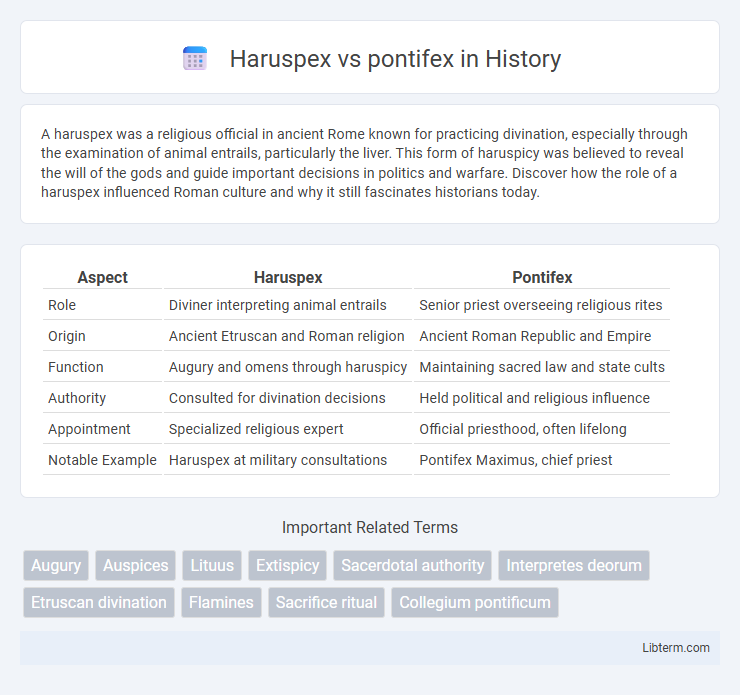A haruspex was a religious official in ancient Rome known for practicing divination, especially through the examination of animal entrails, particularly the liver. This form of haruspicy was believed to reveal the will of the gods and guide important decisions in politics and warfare. Discover how the role of a haruspex influenced Roman culture and why it still fascinates historians today.
Table of Comparison
| Aspect | Haruspex | Pontifex |
|---|---|---|
| Role | Diviner interpreting animal entrails | Senior priest overseeing religious rites |
| Origin | Ancient Etruscan and Roman religion | Ancient Roman Republic and Empire |
| Function | Augury and omens through haruspicy | Maintaining sacred law and state cults |
| Authority | Consulted for divination decisions | Held political and religious influence |
| Appointment | Specialized religious expert | Official priesthood, often lifelong |
| Notable Example | Haruspex at military consultations | Pontifex Maximus, chief priest |
Introduction to Haruspex and Pontifex
Haruspex and pontifex were key religious officials in ancient Rome, each serving distinct sacred functions. The haruspex specialized in divination through the examination of animal entrails, interpreting omens to guide public and political decisions. Conversely, the pontifex was a high-ranking priest responsible for overseeing religious rites, maintaining the pax deorum, and regulating the Roman religious calendar.
Origins and Historical Background
Haruspices were Etruscan diviners specializing in liver inspection to interpret omens, predating Roman religious practices and influencing early ritualistic traditions. Pontifices, emerging within Roman religion, served as high priests overseeing public worship, legal interpretations of religious law, and the Roman calendar. The transition from haruspices to pontifices reflects a shift from external divinatory practices to institutionalized state religion in ancient Rome.
Roles and Responsibilities
Haruspices specialized in divination through the inspection of animal entrails, providing crucial insights for public and military decisions in ancient Rome. Pontifices, as members of the Collegium Pontificum, managed religious law, supervised rituals, and maintained the Roman calendar to ensure proper observance of festivals. While haruspices focused on interpreting omens, pontifices held broader authority over religious practices and legal regulations within Roman society.
Rituals and Practices
Haruspices specialized in interpreting omens through the inspection of animal entrails, particularly the liver, conducting detailed sacrificial rituals to predict future events for Roman officials and the public. Pontifices, as high priests, oversaw broader religious practices, maintaining the pax deorum by regulating state rituals, calendar observances, and sacred law, including the administration of sacrifices and festivals. The haruspex's role was more divinatory and predictive, while the pontifex held authoritative power over the formal and communal aspects of Roman religious ceremonies.
Symbols and Tools of the Trade
Haruspices employed the liver model and haruspicy knives to interpret the will of the gods through animal entrails, especially focusing on the liver's shape and markings. Pontifices used the lituus, a crooked staff symbolizing their authority, along with inscriptions and official records to oversee religious law and ceremonies. These distinct tools highlight the haruspex's role in divination and the pontifex's function in religious governance within ancient Roman religion.
Haruspex: Methods of Divination
Haruspex were ancient Roman priests specializing in haruspicy, a method of divination that involved examining the entrails, particularly the liver, of sacrificed animals to predict future events or interpret the will of the gods. Unlike pontifices, who oversaw religious law and public rituals, haruspices performed detailed inspections of organ abnormalities, believing these signs revealed divine messages. The meticulous analysis of size, shape, color, and texture of the entrails formed the core of haruspex practices, which guided political and military decisions in Rome.
Pontifex: Religious Authority and Duties
The pontifex held significant religious authority in ancient Rome, overseeing public rituals, maintaining the pax deorum, and regulating the Roman calendar to ensure proper festival observance. As chief priest, the pontifex maximus supervised other priests and sacred rites, symbolizing the state's connection to divine favor. Unlike the haruspex, who specialized in divination through animal entrails, the pontifex maintained broad, institutional religious duties vital for social and political stability.
Influence on Roman Society
Haruspices, as diviners specializing in inspecting animal entrails, influenced Roman military and political decisions by interpreting omens critical to state rituals. Pontifices held broader religious authority, overseeing the College of Pontiffs and regulating public religious practices, laws, and calendars, shaping Roman legal and social order. The combined influence of haruspices' ritualistic insights and pontifices' institutional control reinforced the intertwining of religion and governance in Roman society.
Differences and Similarities
Haruspices and pontifices were both key religious officials in ancient Rome responsible for interpreting divine will, but their roles differed significantly in practice; haruspices specialized in haruspicy, the inspection of animal entrails for omens, while pontifices oversaw the broader religious law and rituals, including the calendar and public sacrifices. Both shared the authority to advise magistrates and conduct ceremonies, highlighting their integral status in Roman state religion. Despite their overlapping influence, the pontifex held a more administrative and legalistic role, contrasting with the haruspex's specialized focus on augury and divination.
Legacy and Modern Interpretations
The legacy of haruspices, ancient Roman priests specializing in divination through inspecting animal entrails, contrasts with pontifices who functioned as chief religious authorities overseeing public rituals and legal religious matters. Modern interpretations view haruspices as symbolizing esoteric and mystical knowledge, often linked to early divination practices, while pontifices are seen as precursors to structured religious offices influencing contemporary ecclesiastical hierarchies. The enduring influence of pontifical roles is evident in the Roman Catholic Church's pontiff title, highlighting an institutional continuity absent in the more obscure and ritual-centric legacy of haruspices.
Haruspex Infographic

 libterm.com
libterm.com